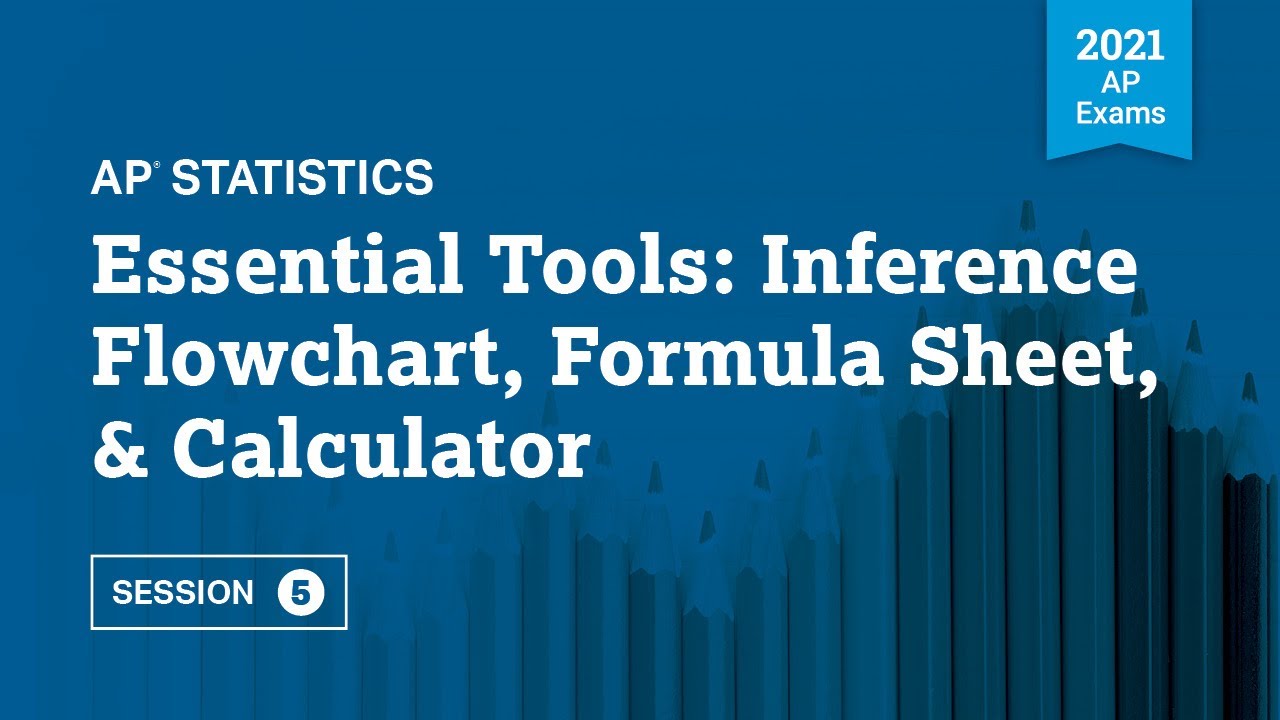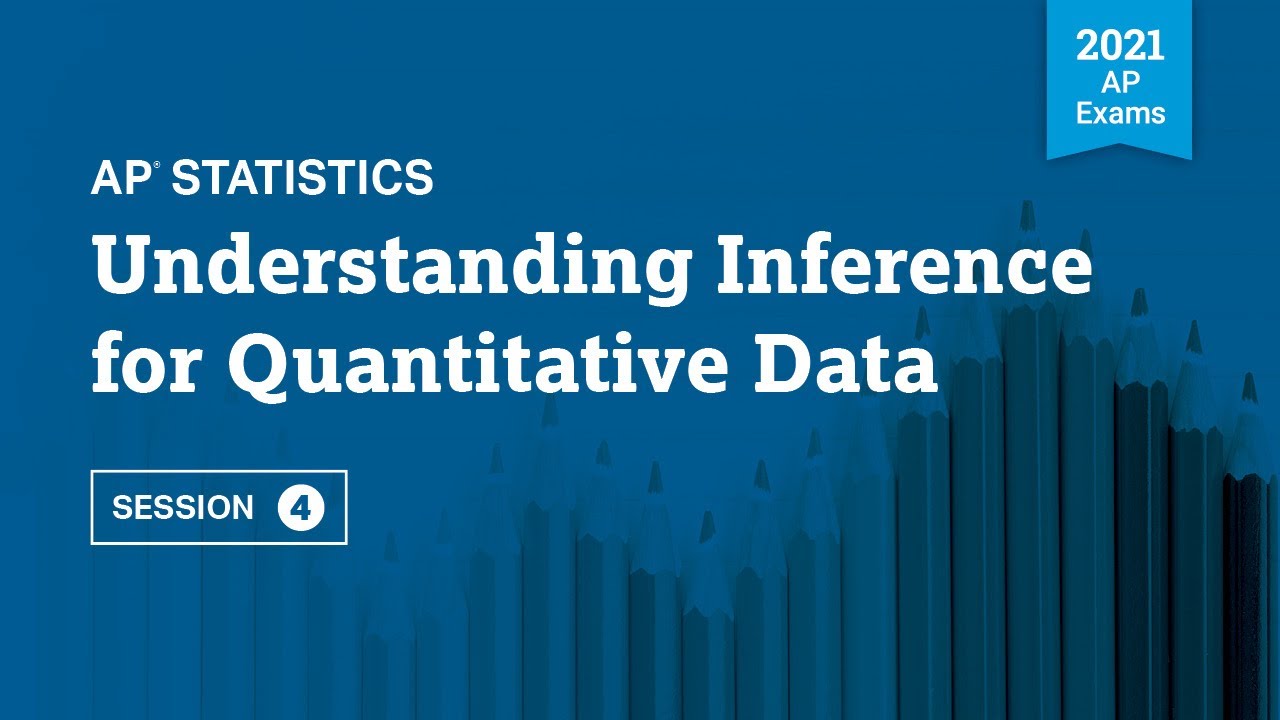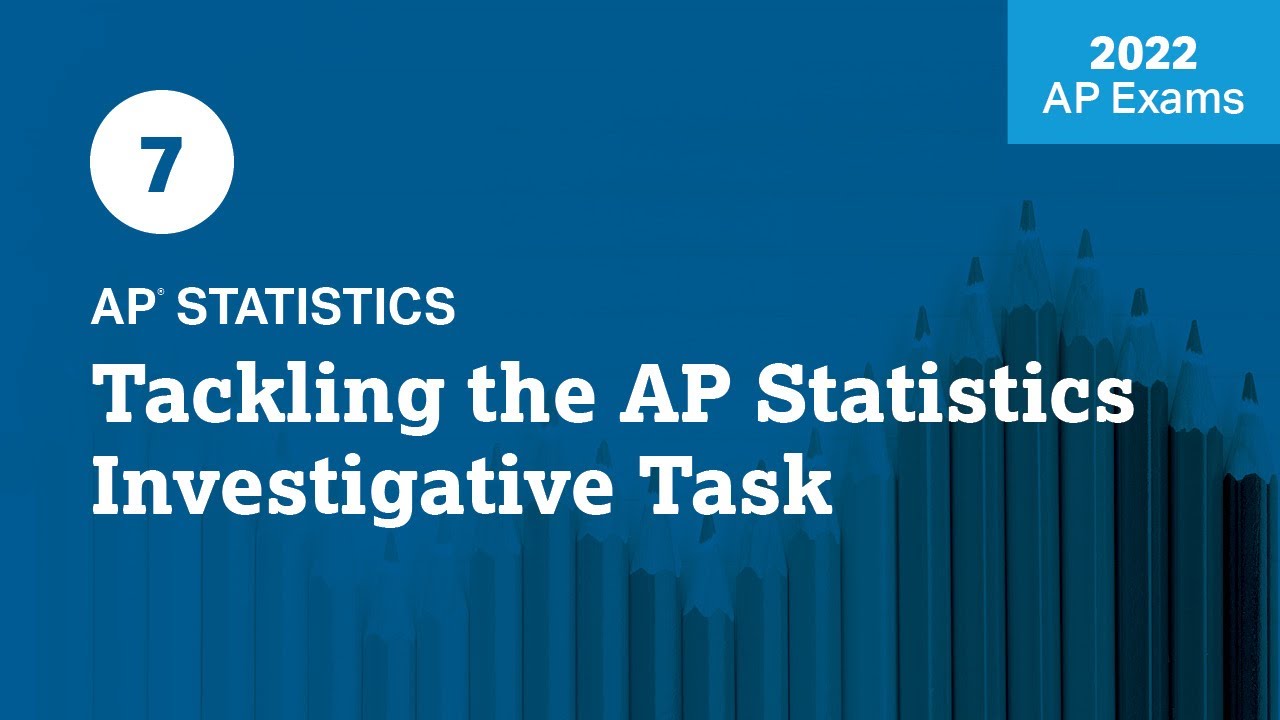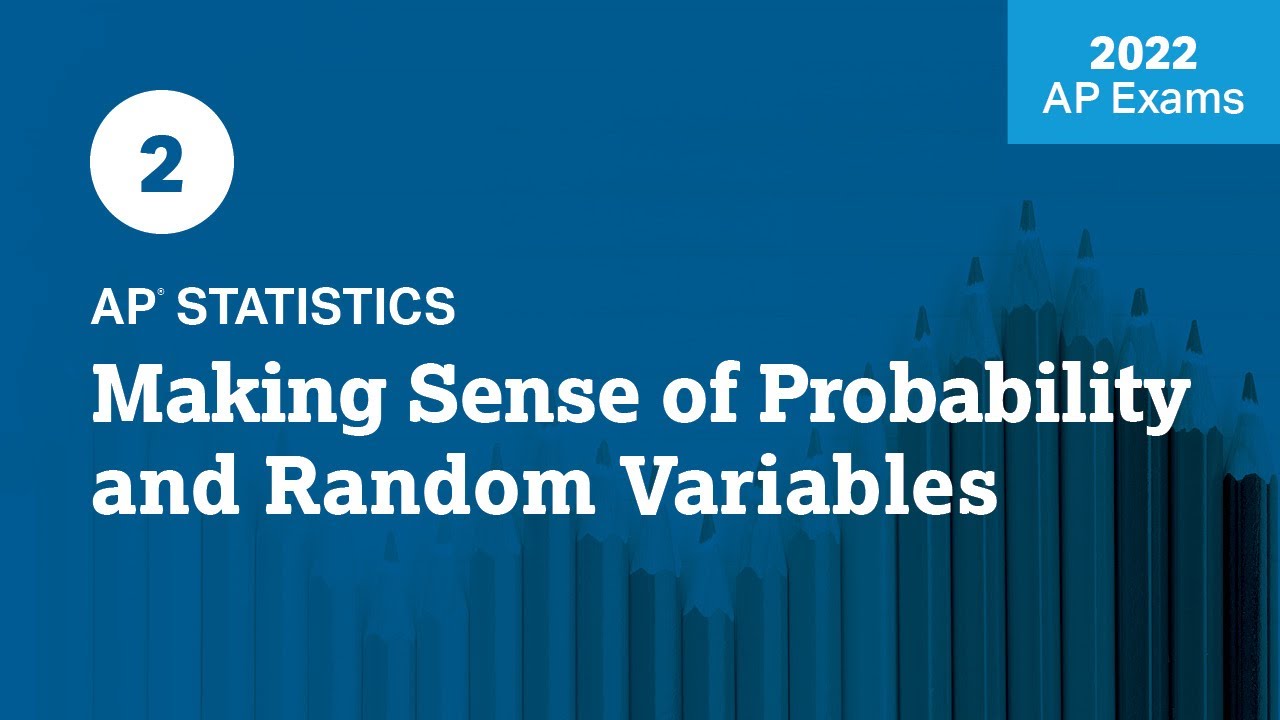2022 Live Review 5 | AP Statistics | Vital Resources for the AP Exam: Inference Flowchart
TLDRIn this AP Statistics live review session, instructor Darren Starns guides students through essential exam strategies, focusing on vital resources like the inference flowchart, formula sheet, and graphing calculator. He demonstrates how to apply these tools to solve inference problems, including identifying correct procedures, calculating probabilities, and constructing confidence intervals. The session aims to build students' confidence and maximize exam scores by practicing with multiple-choice and free-response questions.
Takeaways
- 📚 The session focuses on reviewing essential content and skills for AP Statistics, aiming to build confidence and maximize exam scores.
- 🔍 The presenter introduces three vital resources for the AP exam: the inference flow chart, the formula sheet, and the calculator, emphasizing their importance in solving statistical problems.
- 📈 The inference flow chart is a tool to help identify the correct statistical inference procedure when faced with a new question, crucial for both multiple-choice and free-response questions.
- 📝 The formula sheet is organized into sections for descriptive statistics, probability and distributions, and inferential statistics, providing formulas necessary for various statistical tests.
- 📉 The session demonstrates the use of the TI-84 calculator for descriptive statistics, probability distributions, and inferential tests, highlighting its utility in AP Statistics exams.
- 📑 The presenter explains how to use the formula sheet and calculator together to solve problems, such as calculating standard errors and constructing confidence intervals.
- 📐 The importance of distinguishing between one-sample, paired, and two-sample data is discussed, as it directs the choice of the correct statistical test.
- 🤔 The script encourages active reading and strategic problem-solving, such as using the complement rule to simplify calculations in geometric probability.
- 📝 The presenter provides examples of how to use both the formula sheet and calculator to calculate binomial and geometric probabilities, offering alternatives based on student comfort and accuracy.
- 📉 The session illustrates the process of constructing a confidence interval using the inference flow chart, formula sheet, and calculator, emphasizing the importance of showing work for full credit.
- 📚 The importance of practice and reinforcement is stressed, with a reminder to utilize additional resources like AP Classroom for further study and review.
Q & A
What is the main purpose of the 'Inference Flow Chart' discussed in the session?
-The main purpose of the 'Inference Flow Chart' is to help students identify the correct statistical inference procedure to use when encountering a new question, by guiding them through a series of questions about their data set.
What are the three vital resources for AP Statistics exam success mentioned in the session?
-The three vital resources for AP Statistics exam success mentioned are the Inference Flow Chart, the Formula Sheet, and the Graphing Calculator.
How does the session suggest using the Inference Flow Chart to determine the correct statistical test for a given scenario?
-The session suggests using the Inference Flow Chart by first identifying the individuals or cases in the data set, then determining the variable(s) of interest, classifying the variable(s) as categorical or quantitative, and finally, using this information to navigate through the flow chart to the correct inference procedure.
What is the significance of understanding the difference between categorical and quantitative data in the context of statistical inference?
-Understanding the difference between categorical and quantitative data is crucial for statistical inference because it is the key to selecting the appropriate inference procedure, as different procedures are used for analyzing different types of data.
How does the session describe the organization of the Formula Sheet provided for the AP Statistics exam?
-The session describes the Formula Sheet as being organized into three distinct sections: Descriptive Statistics, Probability and Distributions, and Inferential Statistics. It includes formulas for sample means, standard deviations, regression equations, probability calculations, and standardized test statistics, among others.
What is the role of the Graphing Calculator in the context of the AP Statistics exam?
-The role of the Graphing Calculator in the AP Statistics exam is to assist students in performing complex calculations, such as those required for descriptive statistics, probability distributions, and inferential statistics tests. It can save time and increase accuracy during the exam.
Can you provide an example of how the session uses the Inference Flow Chart to solve a multiple-choice question about battery life?
-The session uses the Inference Flow Chart to identify that the question involves quantitative data about means and that it is a two-sample, independent test to determine if one brand of batteries lasts longer than another. Following the flow chart leads to the conclusion that a two-sample t-test is the appropriate statistical method to use.
What is the importance of reading carefully and actively when approaching statistical inference problems, as suggested in the session?
-Reading carefully and actively is important for identifying key words or phrases in a question that can guide the selection of the correct inference procedure. This strategy helps to avoid mistakes and ensures that the correct method is applied to the problem at hand.
How does the session illustrate the use of the Formula Sheet to calculate the standard error for a confidence interval about the difference in proportions?
-The session demonstrates using the Formula Sheet to find the appropriate standard error formula for a confidence interval about the difference in proportions. It involves using the sample proportions and sizes from two groups to calculate the standard error, which is then used in the confidence interval formula.
What advice does the session give regarding when to use the Formula Sheet versus when to use the Calculator for statistical calculations?
-The session advises using the Formula Sheet when it is efficient and when you need to show your work, such as on a free-response question. The Calculator is recommended for its speed and accuracy, especially when dealing with multiple calculations or when pacing is a concern, such as on multiple-choice questions.
Outlines
📚 Introduction to AP Statistics Review Session
In this introductory paragraph, Darren Starns, an experienced AP Statistics teacher and exam reader, welcomes students to session five of the AP Daily Live Review. He outlines the purpose of the session, which includes reviewing essential content, sharing strategies for exam success, and boosting students' confidence. The session's materials, including a handout, formula sheet, and the new inference flowchart, are mentioned, all accessible via a provided tiny URL. The importance of having a graphing calculator, specifically a TI-84, is highlighted for interactive learning during the session.
📈 Utilizing the Inference Flowchart for AP Exam
The paragraph focuses on the importance of the inference flowchart, a tool designed to assist students in selecting the correct statistical inference procedure when faced with a new question. The process of using the flowchart involves identifying the type of data and the nature of the inference, whether it's about categorical or quantitative data. An example of a multiple-choice question about battery life is used to demonstrate the step-by-step application of the flowchart, leading to the selection of a two-sample t-test for the difference in means.
📝 Reviewing the Formula Sheet and Its Organization
This paragraph delves into the organization and utility of the formula sheet, which is divided into three sections: descriptive statistics, probability and distributions, and inference. The formula sheet is designed to be used in conjunction with specific inference procedures for test statistics or confidence intervals. The paragraph also discusses the importance of recognizing which formulas are more frequently applicable and the necessity of adapting generic formulas to specific inference needs.
📊 Understanding the Formula Sheet's Probability Distributions
The paragraph provides an in-depth look at the probability distributions section of the formula sheet, covering discrete random variables such as binomial and geometric distributions. It explains how to use the provided table for calculating probabilities, means, and standard deviations for these distributions. The paragraph also touches on the general inference information about sampling distributions and inferential statistics, including standardized test statistics and confidence intervals.
📉 Analyzing the Appropriate Standard Error for Confidence Intervals
The paragraph discusses how to determine the most appropriate standard error for constructing a confidence interval for the difference in proportions, using a multiple-choice question about sleep and exercise habits as an example. It emphasizes the importance of identifying the correct formula from the formula sheet for calculating the standard error in the context of two populations and explains the process of elimination for incorrect answer choices.
🔢 Leveraging the TI-8384 Calculator for Statistical Analysis
This paragraph highlights the three main areas of the TI-8384 calculator that correspond to the formula sheet sections: descriptive statistics, probability distributions, and inference. It explains how to use the calculator for various statistical tasks, such as obtaining linear regression equations and calculating probabilities for different distributions. The paragraph also addresses the question of when to use the formula sheet versus the calculator for optimal efficiency in solving statistical problems.
🎯 Combining Resources for Effective Statistical Problem-Solving
The paragraph illustrates the combined use of the inference flowchart, formula sheet, and calculator to solve statistical problems. It provides an example of a multiple-choice question regarding teacher salaries in different regions and demonstrates the process of using the flowchart to identify the correct inference method, the formula sheet for calculations, and the calculator for obtaining the p-value and degrees of freedom.
🌱 Constructing a Confidence Interval for Mean Difference in a Plant Growth Experiment
This paragraph presents a free-response question about a plant growth experiment, where seeds are treated with additives to enhance growth. It discusses the use of the inference flowchart to determine the appropriate inference method, the formula sheet for calculating the standard error, and the calculator for constructing a confidence interval for the mean difference in plant growth. The paragraph emphasizes the importance of interpreting the confidence interval in the context of the experiment's results.
📘 Strategies for AP Statistics Exam Success
The final paragraph summarizes the strategies for success on the AP Statistics exam based on the session's content. It advises students to use the inference flowchart to select the correct statistical method, choose between the formula sheet and calculator based on their comfort and the situation, and continue building confidence to maximize exam scores. The paragraph also reminds students of additional resources available in AP Classroom for further review and practice.
Mindmap
Keywords
💡AP Statistics
💡Inference Flow Chart
💡Formula Sheet
💡Graphing Calculator
💡Chi-Square Test
💡Two-Sample T-Test
💡Confidence Interval
💡Significance Level (Alpha)
💡Null Hypothesis
💡P-Value
💡Descriptive Statistics
💡Random Sample
💡Geometric Random Variable
💡Binomial Random Variable
Highlights
Introduction to AP Daily Live Review session five with Darren Starns, an experienced AP Statistics teacher and exam reader.
Importance of having the session 5 handout, formula sheet, tables, and the new inference flowchart for the session.
Efficiency in accessing resources through the provided TinyURL with direct links to the session's materials.
The significance of the inference flowchart in selecting the appropriate statistical inference procedure.
A step-by-step guide on using the inference flowchart with an example question about battery life comparison.
Explanation of the 13 different inference procedures for the AP Statistics exam and their organization by unit.
The role of the graphing calculator, specifically the TI-84, in solving statistical problems during the session.
Review of essential content and skills, strategies for AP Statistics exam success, and confidence building for students.
Detailed walkthrough of a multiple-choice question involving service request proportions using the inference flowchart.
Discussion on the organization and utility of the formula sheet for descriptive statistics, probability, and inferential statistics.
Use of the formula sheet for calculating standard errors in constructing confidence intervals for differences in proportions.
Highlighting the three main areas of the TI-8384 calculator: descriptive statistics, distributions, and inference.
Guidance on choosing between using the formula sheet and the calculator for different types of statistical problems.
Example of calculating binomial and geometric probabilities using both the formula sheet and calculator functions.
Illustration of constructing a confidence interval for a mean difference using the inference flowchart, formula sheet, and calculator.
Advice on using the inference flowchart to ensure the correct inference method is selected for exam questions.
Recommendation to use the formula sheet and calculator based on individual confidence and the need for accuracy and time efficiency.
Conclusion summarizing the importance of using the three vital resources effectively to maximize the AP exam score.
Transcripts
Browse More Related Video

2021 Live Review 5 | AP Statistics | Essential Tools Inference Flowchart, Formula Sheet & Calculator

2021 Live Review 4 | AP Statistics | Understanding Inference for Quantitative Data

2022 Live Review 7 | AP Statistics | Tackling the AP Statistics Investigative Task

2022 Live Review 2 | AP Statistics | Making Sense of Probability & Random Variables

2021 Live Review 6 | AP Statistics | Rubrics for Free-Response Success on the AP Statistics Exam

2021 Live Review 8 | AP Statistics | Top 10 Tips for Success on the AP Statistics Exam
5.0 / 5 (0 votes)
Thanks for rating: